Vertical gardening is a game-changer for small spaces. It lets people turn neglected areas into lush gardens. By using walls and trellises, anyone can grow a garden, no matter the space size.
This method is great for both indoor and outdoor spaces. It’s perfect for urban gardening. It turns small spaces into green oases.
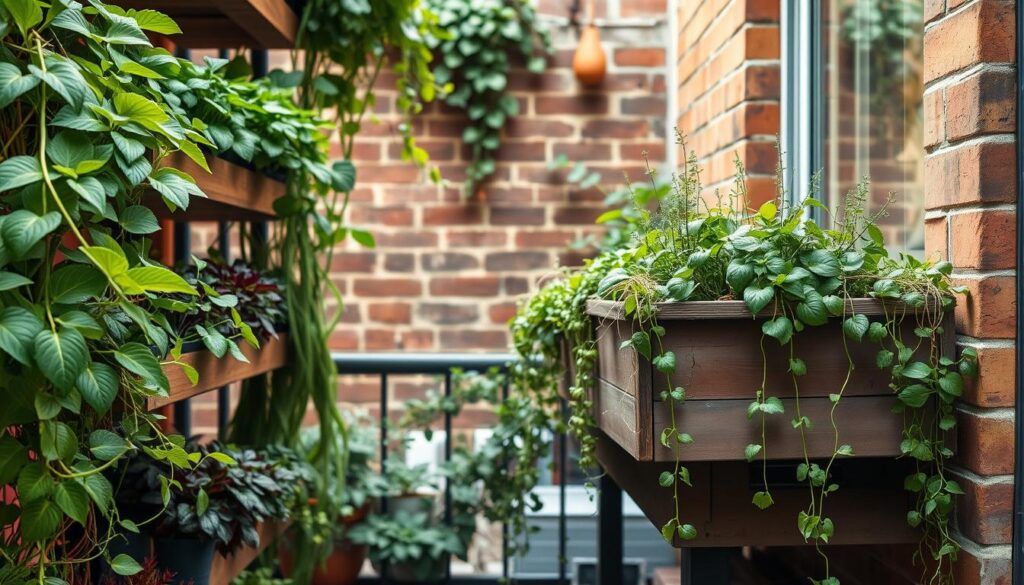
Vertical gardening lets people enjoy gardening in small spaces. It’s ideal for small space gardening and urban gardening. It adds beauty to a space and lets you grow plants, herbs, and veggies.
This brings a sense of well-being and connects you to nature. It’s a way to make the most of small spaces.
Key Takeaways
- Vertical gardening is perfect for small space gardening and urban gardening.
- It allows individuals to transform neglected areas into lush gardens.
- Vertical gardening promotes a sense of well-being and connection to nature.
- It enables people to make the most of their limited space.
- Vertical gardening is ideal for growing plants, herbs, and vegetables in small spaces.
Understanding the Basics of Vertical Gardening
Vertical gardening is a smart way to grow plants, perfect for those with little space. It lets people create lush gardens in small spots like balconies or indoor rooms. Over time, new techniques and tools have made it even better.
Vertical gardens are great because they boost yields, improve air quality, and look beautiful. When planning your garden, think about light, temperature, and wall space. This helps your garden grow well in its spot.
What Makes Vertical Gardening Different
Vertical gardening is unique because it uses space in a new way. It’s perfect for small areas, like balconies or indoor spots. This method is especially good for indoor gardening where space is tight.
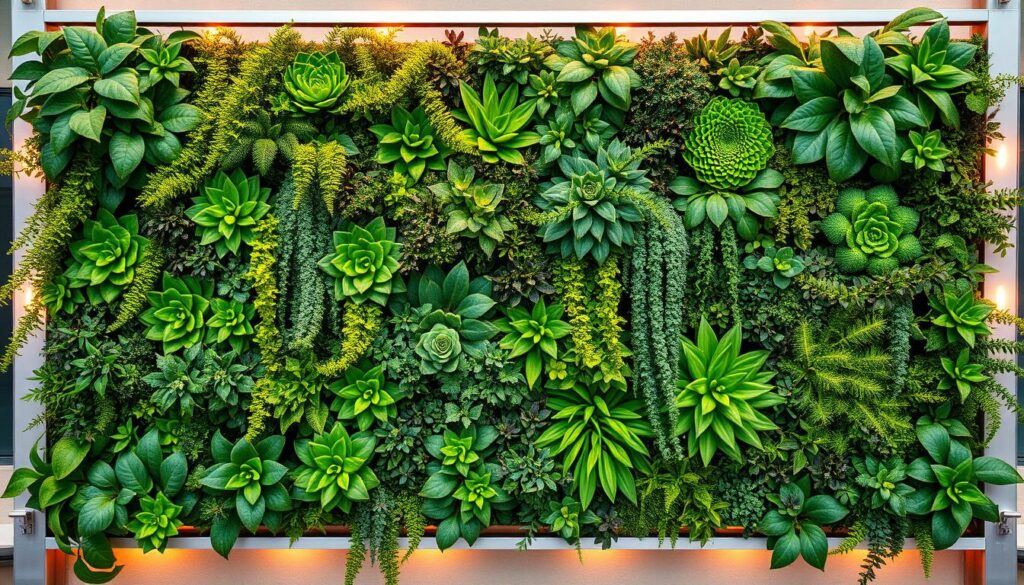
Benefits of Growing Upward
Vertical gardening has many perks, like more plants, cleaner air, and better looks. Some main benefits are:
- Space efficiency: It uses your space well.
- Improved air quality: It helps clean the air inside.
- Increased yields: You get more harvests.
Assessing Your Space Requirements
Before starting a vertical garden, check your space. Think about light, temperature, and wall space. Knowing this helps your garden do well in its spot. By understanding vertical gardening and checking your space, you can make a garden that’s full of life and benefits.
Essential Tools and Materials for Vertical Gardens
Creating and keeping a vertical garden needs the right tools and materials. For those who love outdoor gardening, using sustainable practices is key. You’ll need planters or pockets for soil and plants, trellises for climbing plants, and a good irrigation system.
For materials, sustainable options like recycled plastic or wood are great. They help make your garden eco-friendly. Here are some important materials to think about:
- Planters or pockets made from sustainable materials
- Trellises or other supports for climbing plants
- Efficient irrigation systems
- Sustainable materials for planters and supports, such as recycled plastic or wood
Using these tools and materials in your vertical garden makes it thrive. It becomes a beautiful and green space that’s good for the planet and your home.
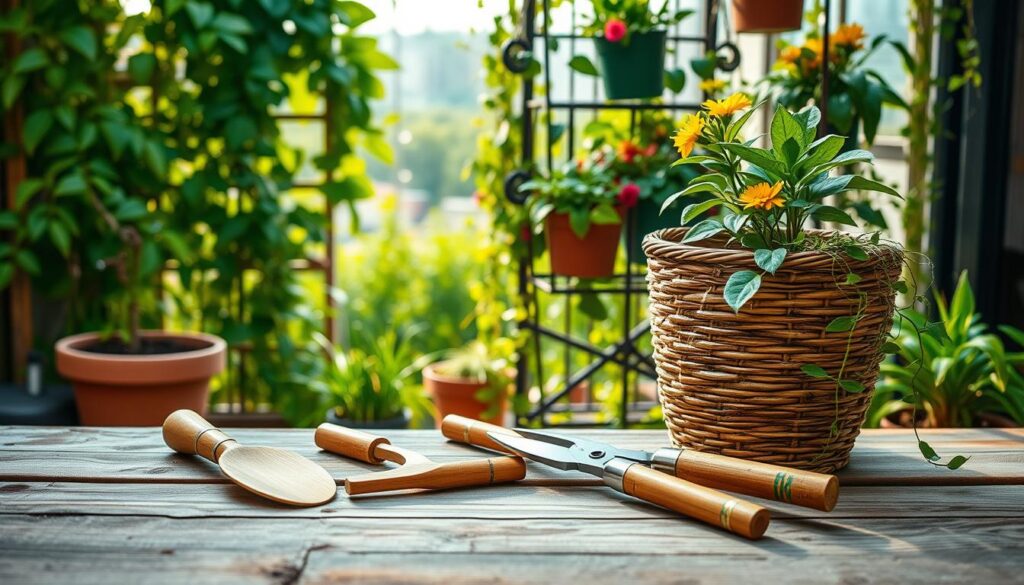
Starting your vertical garden journey? Pick materials and tools that match your values and goals. With the right stuff, you’ll have a beautiful and green garden that brings you joy for years.
Creative Wall-Mounted Planting Systems
For those who love small space gardening, wall-mounted planting systems are a great choice. They help you use your space wisely, letting you grow many plants in a small area. These systems turn small spots into green, colorful gardens.
Wall-mounted systems are very flexible. You can pick from pocket planters, fabric setups, or even old pallets. They fit on walls, fences, or other vertical spots, saving space. Some favorites include:
- Pocket planters: These have small pockets for soil and plants, perfect for tight spots.
- Fabric solutions: They’re light, simple to put up, and come in materials like cotton and polyester.
- Repurposed pallets: Old pallets become useful planters, offering a green way to grow plants.
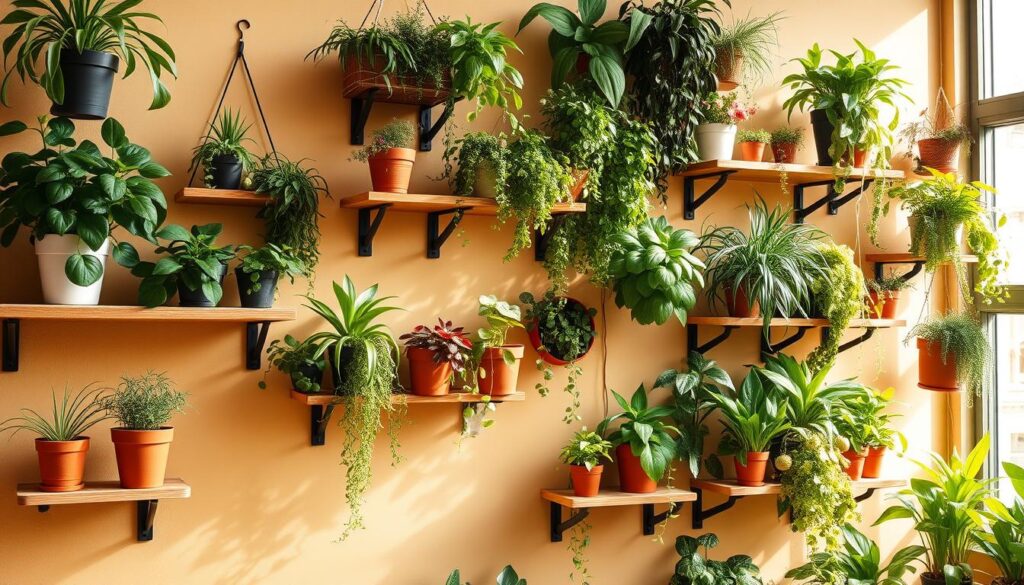
Using these creative systems in small space gardening lets you grow beautiful gardens. They make your space look better and help you grow food and plants. Whether you’re new to gardening or have experience, these systems are a smart way to use your space. They help you reach your gardening dreams with space-saving gardening techniques.
Innovative Vertical Gardening Ideas to Maximize Small Spaces
Urban gardening is on the rise, with people wanting to turn small spaces into gardens. Vertical garden designs are a great way to do this. They let plants grow up, making the most of space and adding greenery to any area.
There are many creative ways to garden vertically, like living walls, green facades, and indoor herb gardens. These not only look unique but also improve air quality and boost food production. By using vertical gardening, small spaces can become lush and productive gardens.
Vertical gardening offers endless possibilities. Here are some popular choices:
- Living walls: These are walls covered in plants, perfect for indoors or outdoors.
- Green facades: Exterior walls covered in plants that enhance air quality and reduce noise.
- Indoor herb gardens: Small gardens indoors that provide fresh herbs all year.
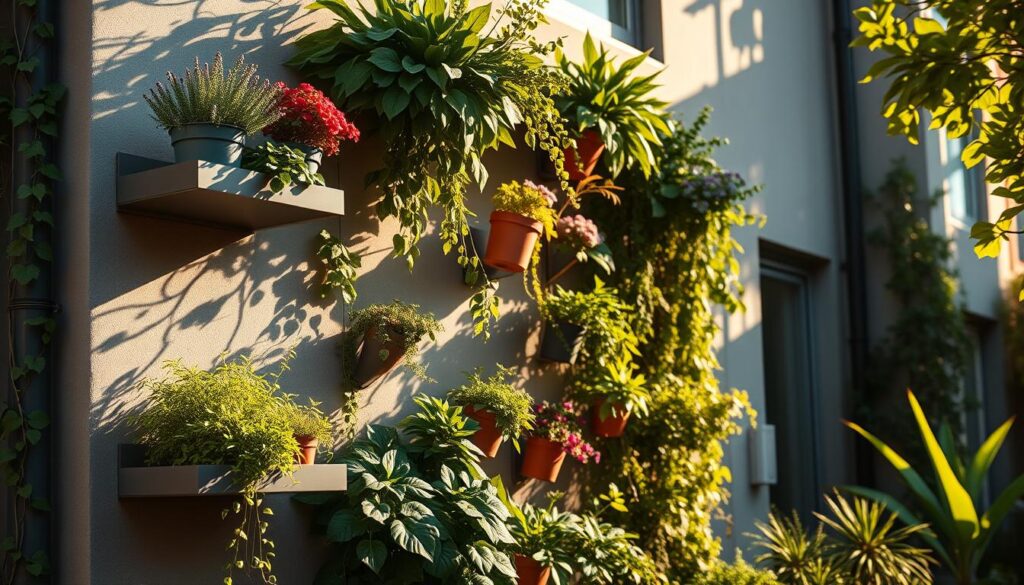
By adopting these ideas, people can create beautiful, functional spaces. These spaces not only enhance life quality but also support a sustainable future. Whether you have a balcony, rooftop, or backyard, vertical gardens can maximize your space and offer many benefits.
| Vertical Gardening Idea | Benefits |
|---|---|
| Living Walls | Improved air quality, increased food production |
| Green Facades | Improved air quality, reduced noise pollution |
| Indoor Herb Gardens | Fresh herbs year-round, improved air quality |
Selecting the Right Plants for Vertical Growth
Choosing the right plants is key for a successful indoor garden. Look for plants that are small, make little mess, and do well indoors. This is great for sustainable gardening, as it saves space and reduces environmental impact.
Climbing plants and vines like ivy and clematis are great for vertical gardens. They can grow up supports. For food, compact vegetables like cherry tomatoes and leaf lettuce are perfect. Herbs like basil, mint, and rosemary also do well indoors and add flavor to meals.
Climbing Plants and Vines
- Ivy: easy to train and maintain
- Clematis: produces beautiful flowers and can thrive in indoor conditions
Compact Vegetables for Vertical Gardens
- Cherry Tomatoes: produce high yields and are easy to care for
- Leaf Lettuce: can be harvested in as little as 20 days and can thrive in indoor conditions
Best Herbs for Vertical Spaces
- Basil: adds freshness to any dish and can thrive in indoor conditions
- Mint: easy to grow and can be used in a variety of dishes
- Rosemary: produces beautiful flowers and can thrive in indoor conditions
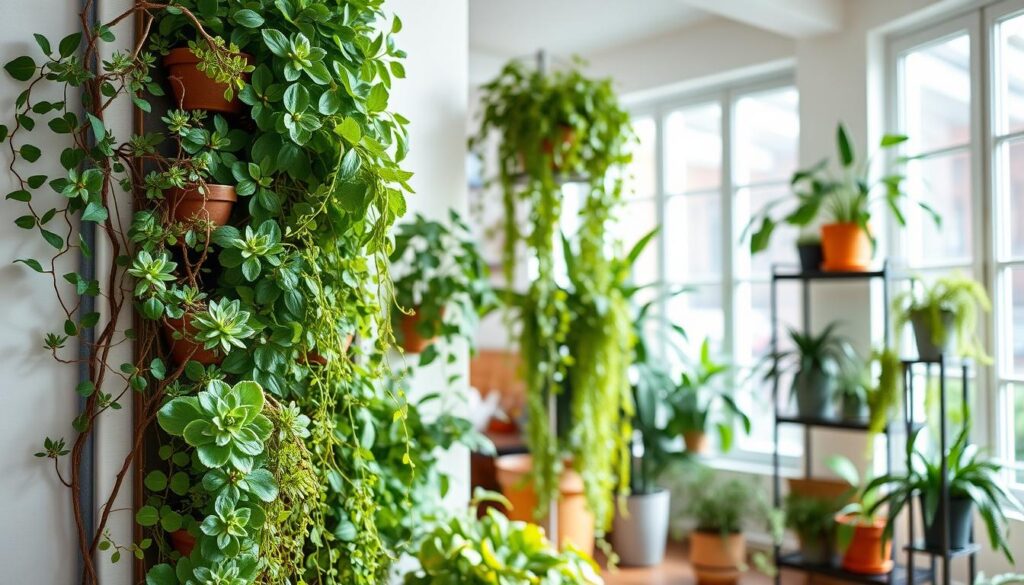
By picking the right plants for your vertical garden, you can enjoy a lush and sustainable space. It will bring freshness and beauty to your home.
| Plant Type | Benefits | Space Requirements |
|---|---|---|
| Climbing Plants and Vines | Easy to train, produces beautiful flowers | Minimal space required |
| Compact Vegetables | High yields, easy to care for | Small space required |
| Herbs | Easy to grow, adds freshness to dishes | Minimal space required |
Smart Space-Saving Irrigation Solutions
Outdoor gardening needs efficient irrigation systems to keep plants healthy. Drip irrigation is a top choice for saving space. It waters plants at their roots, cutting down on evaporation and runoff. This method saves water and prevents too much or too little water, perfect for outdoor gardens.
Here are the main benefits of drip irrigation:
- Water conservation: Drip irrigation systems use up to 50% less water than traditional sprinkler systems.
- Increased crop yields: Drip irrigation ensures plants get the right amount of water, leading to better growth and higher yields.
- Reduced soil erosion: It helps prevent soil erosion by reducing runoff and soil compaction.
Other techniques like soaker hoses and micro-sprinklers also save space in outdoor gardens. They deliver water directly to the roots, reducing evaporation and runoff. These smart solutions help gardeners water their plants efficiently, saving water in the process.
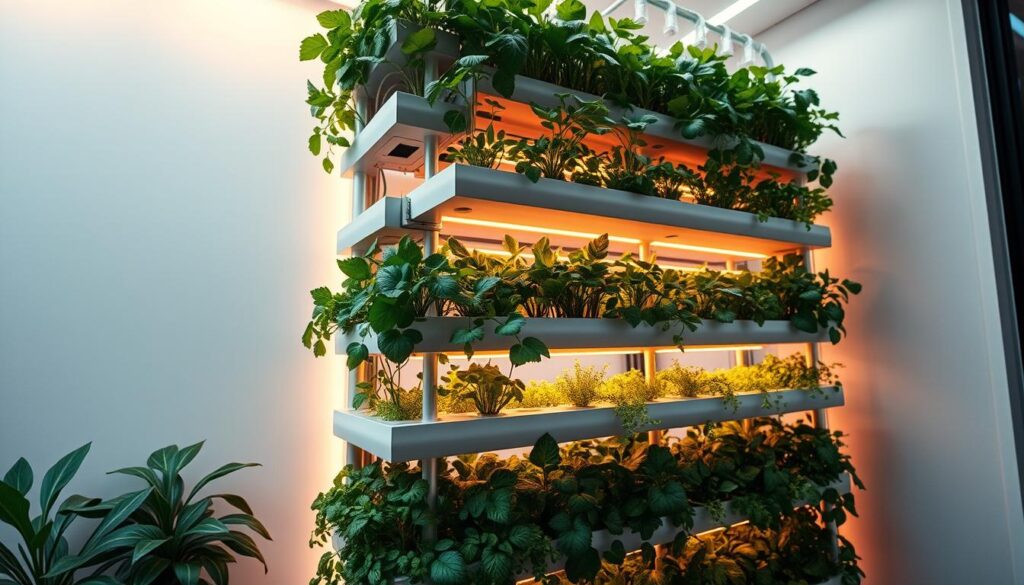
Using these innovative irrigation methods, gardeners can grow thriving gardens in small spaces. Whether you’re new to gardening or have experience, these techniques can greatly improve your plants’ health and productivity.
| Irrigation System | Water Conservation | Crop Yield |
|---|---|---|
| Drip Irrigation | Up to 50% | Higher crop yields |
| Soaker Hoses | Up to 30% | Improved plant growth |
| Micro-Sprinklers | Up to 20% | Increased crop yields |
Living Walls and Green Facades
Urban gardening is getting more popular, especially with living walls, or green facades. These vertical gardens make buildings look great. They also help clean the air and support more wildlife.
There are two ways to make a living wall: using professional systems or doing it yourself. Professional systems are pricey but easy to care for. DIY methods are cheaper and let you be creative with your garden.
Benefits and Challenges
- Improved air quality
- Increased biodiversity
- Enhanced aesthetic appeal
- Maintenance requirements, such as watering and pruning
- Plant selection, choosing species that thrive in vertical conditions
Living walls and green facades are great for urban gardening. They turn any space into a green oasis. With the right plants and care, you can enjoy a beautiful, beneficial garden.
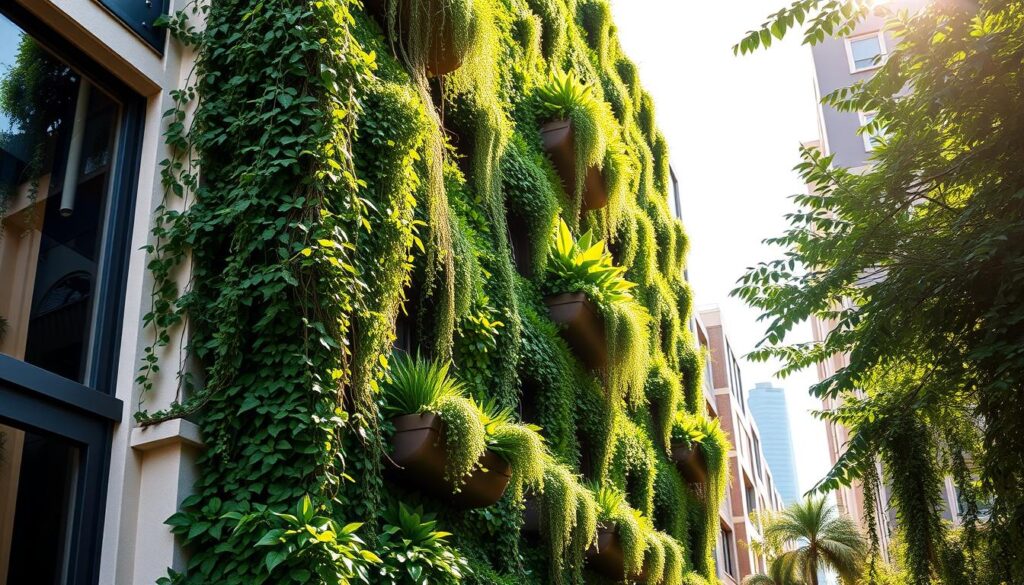
Balcony and Patio Vertical Garden Designs
Small space gardening can be a challenge, but with the right design and plants, even the smallest balconies and patios can be transformed into vibrant gardens. Outdoor gardening on balconies and patios requires careful planning to maximize the use of space. One way to achieve this is by incorporating a mix of planters, hanging baskets, and trellises, creating a layered and textured look.
When designing a vertical garden for a balcony or patio, consider the amount of sunlight the area receives and choose plants that thrive in those conditions. Some popular plants for small space gardening include herbs, succulents, and flowering vines. These plants are not only beautiful but also easy to care for, making them perfect for busy individuals who want to enjoy the benefits of outdoor gardening.
To create a functional and inviting outdoor space, incorporate seating areas and decorative elements, such as sculptures or water features. This will enhance the ambiance and make the space more inviting. Here are some ideas for balcony and patio vertical garden designs:
- Use a trellis to support climbing plants and add a decorative element to the space
- Incorporate a seating area with a built-in planter or a hanging basket
- Add a water feature, such as a small fountain or a birdbath, to create a soothing atmosphere
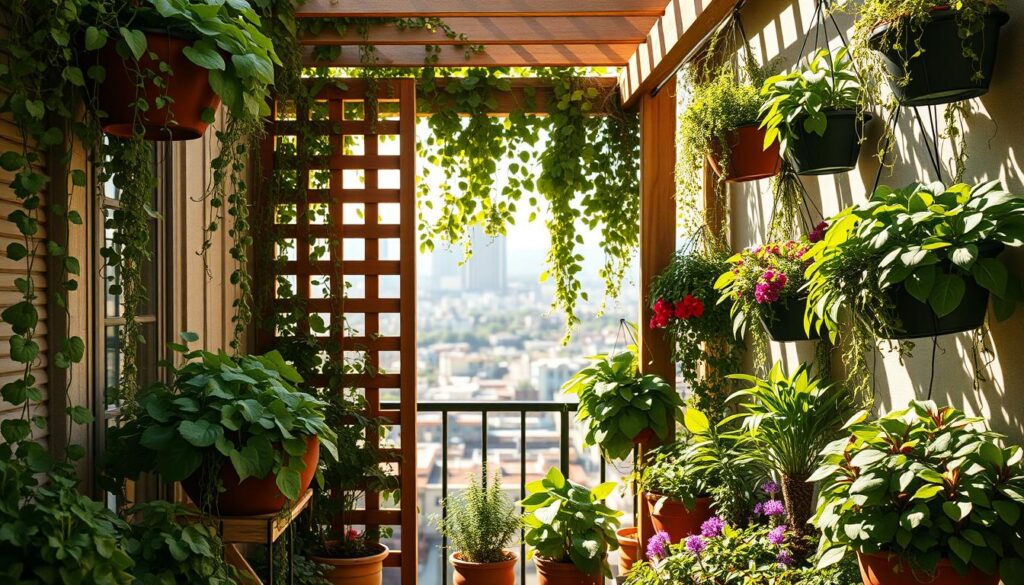
By utilizing vertical space and incorporating these design elements, individuals can create a lush oasis in even the smallest of balconies or patios, perfect for outdoor gardening and relaxation.
| Design Element | Description |
|---|---|
| Trellis | A supportive structure for climbing plants |
| Seating Area | A designated space for relaxation and enjoyment |
| Water Feature | A decorative element that adds a soothing atmosphere |
Troubleshooting Common Vertical Garden Challenges
Vertical gardening has its own set of challenges. One big issue is weight distribution. This can be fixed by using lightweight materials and ensuring plants have the right support. This is especially true for indoor gardening, where saving space is key. With the right materials and techniques, gardeners can make a thriving vertical garden.
Some common challenges faced by vertical gardeners include:
- Weight issues: Using lightweight materials and ensuring proper support for the plants can help alleviate this issue.
- Light exposure: Most plants require adequate light to thrive, so it’s essential to manage light exposure in indoor gardening.
- Water damage: Excessive moisture can lead to mold, rot, and other problems, so it’s crucial to prevent water damage in space-saving gardening techniques.
By understanding and addressing these challenges, gardeners can create a beautiful and sustainable vertical garden.
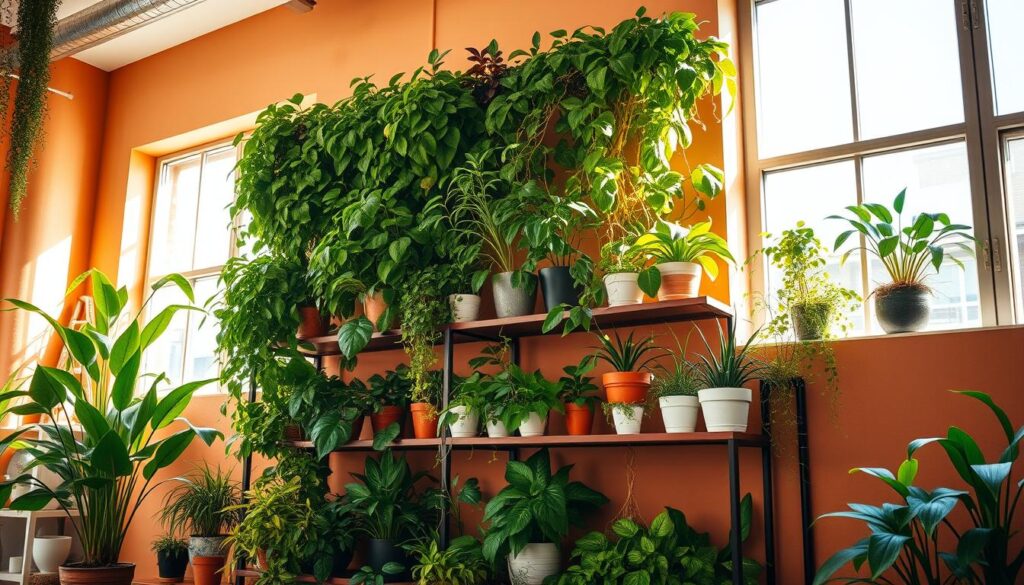
For example, using a trellis or a wall-mounted planter can help distribute the weight of the plants and prevent water damage. Also, using plants with different lighting needs can help manage light in indoor gardening. These space-saving techniques allow gardeners to create a thriving vertical garden that adds joy and freshness to their indoor space. Resets
| Challenge | Solution |
|---|---|
| Weight issues | Use lightweight materials and ensure proper support |
| Light exposure | Manage light exposure with a variety of plants |
| Water damage | Prevent water damage with proper drainage and watering |
Conclusion: Transform Your Small Space into a Vertical Garden Paradise
Urban gardening and vertical gardening ideas open up endless possibilities. They help turn even the smallest spaces into lush gardens. This way, you can grow a lot in a little area, making your space both beautiful and productive.
Whether you have a small balcony, patio, or indoor area, success comes from good planning. Choose the right plants and use smart space-saving ideas. With creativity and the right advice, you can make a stunning vertical garden. It will not only look great but also give you fresh food.
Vertical gardening brings many benefits. It improves air quality, boosts food production, and makes you feel better. It turns your small space into a lively, green oasis that refreshes you every day.
So, why wait? Begin planning your vertical garden now. With the right tools, plants, and imagination, your small space can become anything you dream of.
FAQ
What is vertical gardening, and how does it differ from traditional gardening?
Vertical gardening lets you grow plants in small spaces. You can use walls, trellises, and more. It’s great for small areas, unlike traditional gardening that needs big plots.
What are the benefits of growing a vertical garden?
Vertical gardens offer many perks. They increase yields, improve air quality, and look great. They’re perfect for small balconies, patios, or indoor spaces.
What are some essential tools and materials needed for a vertical garden?
You’ll need planters, trellises, and a good irrigation system. Use eco-friendly materials like recycled plastic or wood. This makes your garden green and sustainable.
What are some innovative wall-mounted planting systems for small spaces?
Try pocket planters, fabric solutions, or repurposed pallet gardens. Grid-style systems also work well. They save space and look good.
What types of plants are best suited for vertical gardening?
Climbing plants and compact veggies like cherry tomatoes are great. Herbs like basil and mint also do well indoors. They add freshness to your food.
How can efficient irrigation systems help with vertical gardening?
Good irrigation saves water and space. Use drip systems to water plants directly. This cuts down on waste and runoff.
What are living walls and green facades, and how can they be incorporated into vertical gardening?
Living walls and green facades are beautiful and beneficial. They improve air quality and look great. DIY versions can be affordable and rewarding. Just remember to water and prune them regularly.
How can I create a vertical garden on a balcony or patio?
Turn balconies and patios into gardens with the right design. Use planters, hanging baskets, and trellises. Add seating and decor for a cozy feel.
What are some common challenges in vertical gardening, and how can they be addressed?
Use lightweight materials to avoid weight issues. Make sure plants get enough light. Avoid too much water to prevent damage. With these tips, your vertical garden will thrive.